
1. The Concept
1.1. Enables people to connect in ways that simply weren’t possible before.
1.2. All business functions
1.2.1. Easily accessed
1.2.2. Can be easily manipulated
1.3. increased productivity rate
1.3.1. Individuals and teams can all participate based on preferred working styles and not interfere with one another
1.4. Competitive advantage
1.4.1. Greater
1.5. Networking platform between two communication channels
1.5.1. More visible and now connects not 2 but multiple communication channels to one place!
1.6. This ensures that the Business can benifit the ever growing economy
2. Techniques Used
2.1. Blogging
2.1.1. Easy
2.1.2. Anyone can put in their input
2.1.3. Useful for business discussions
2.2. Wiki's
2.2.1. Teams can now participate and access the same Project resources from different geographical locations
2.3. RSS Feeds
2.3.1. Updated Content
2.3.2. New node
2.4. Widgets
2.4.1. No Repetition of actions
2.4.2. Single Interaction Point
2.5. Mashups
2.5.1. Mixing and Matching competitor's API to create new product services
2.5.2. Presentation / Interactivity
2.5.2.1. User interface
2.5.2.1.1. HTML / XHTMl
2.5.2.1.2. CSS
2.5.2.1.3. Javascript
2.5.2.1.4. Ajax
2.5.3. Web Services
2.5.3.1. functionality can be accessed
2.5.4. Data
2.5.4.1. Handling the data like sending, storing and receiving is so much easier and more user friendly
2.5.5. Integration
2.5.5.1. Easy & fast
2.6. Cloud Computing
2.6.1. Inexpensive
2.6.1.1. No Hardware & software Purcahsed
2.6.2. Lowers Bandwidth needed
2.6.3. Easier connectivity between thousands of different points of communication
3. Technolgies Used
3.1. Facebook
3.1.1. Easy & cheaper way to connect to customers & suppliers
3.2. Myspace
3.3. Youtube
3.3.1. Advertising Potential is immense
3.4. Blogging Sites
3.5. Classroom Dynamics
3.5.1. Faster data Exchange
3.5.2. Greater data exchange capacity
3.5.3. More effecient way to exchange, manipulate & present Data/Information
3.6. Networking Dynamics
3.6.1. Everyone has equal input, unless restricted
3.6.2. Business teams are more dynamic
4. People who Benefit
4.1. Suppliers
4.1.1. Communication
4.1.1.1. Strengthened due to being real time communication
4.1.1.2. Faster
4.1.1.3. More Reliable
4.1.1.4. Backed up
4.1.2. Relationship
4.1.2.1. Stronger
4.1.3. Competition
4.1.3.1. Suppliers of a business can easily be replaced and better more effecient suppliers can be chosen
4.2. Customers
4.2.1. Future Customers
4.2.1.1. Advertising
4.2.1.1.1. Easier
4.2.1.1.2. Cheaper
4.2.1.1.3. Attract a wider range of Customers
4.2.1.1.4. Allowing Customer to understand exactly what the business is all about
4.2.1.1.5. Advertise Specials and or new Products/ Services
4.2.2. User Functionality is enhanced
4.2.3. Present Customers
4.2.3.1. Current Accounts
4.2.3.1.1. Updated account of outstanding Amounts and other information relating to them
4.2.3.2. Tracking services
4.2.3.2.1. Customers can now track their parcels via internet, and no longer need to phone the business
4.2.3.3. Advertising
4.2.3.3.1. Advertise Specials and or new Products/ Services
4.2.3.3.2. Cheaper
4.2.3.3.3. Easier
4.3. Investors
4.3.1. Can now easily access information required to make a decision if business is a viable investment option, this stems from better information availability from technologies
4.4. Employees
4.4.1. Business can be monitored
4.4.2. Job security promised
4.4.3. Employee's jobs can be done better and faster
4.4.4. Future promotions can be seen
4.5. Economy
4.5.1. Businesses can rely on widespread teams and networks of people who can have real-time access to one another and to common project resources. And the ability to easily interact with customers, vendors and partners is critical to ongoing success.
4.6. The Business Itself
4.6.1. It can now Cost-effectively sell and market wider varieties of products and services to fewer people in niche marketplaces
4.6.2. Business Teams
4.6.2.1. Can geographically be dispersed over a large geographical area
4.6.2.2. Teams can easily monitor what’s new for a project and share feedback and content with one another.
4.6.2.3. Can all access certain information and specific information through a single access point.
4.6.3. Customers
4.6.3.1. Customers can help creating new products or services based on customers’ needs or tastes.
4.6.4. Respond more quickly to changing marketplace conditions.
5. Linkage & Comunication Channels
5.1. More Effecient & Faster Between
5.1.1. Business
5.1.2. Customers
5.1.3. Suppliers
